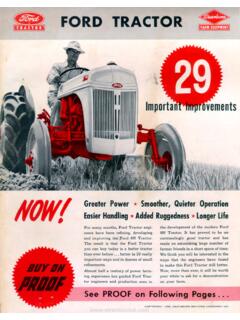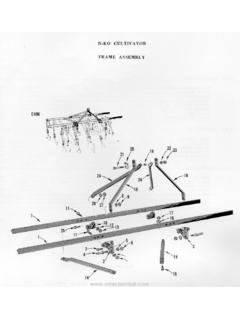Transcription of N-Series Sediment Bowl - Fix for Leaking Valve
1 N-Series Sediment Bowl - Fix for Leaking Valve The fuel Sediment bowl assembly on Ford N-Series tractors requires periodic maintenance like everything else and sometimes we encounter Leaking issues that not only are major safety problems but can be frustrating and aggravating when discovered. Often it isn t until you need the tractor to do some work that you discover the problem and then it puts everything on hold until you can fix it. You certainly don t want to run the tractor with a Leaking fuel bowl. Here is what can happen and a simple fix to correct the problem.
2 The Sediment fuel bowl Valve is a brass screw that opens and closes the inlet inside the bowl top to limit, stop, or allow fuel to flow. There is a small washer that butts up to a shoulder just before the threads on the screw. Behind the washer is a rubber seal and behind that is a line fitting either brass or steel. On the end of the Valve stem is the knurled knob that has a broached square hole in the center, and the instructions, MAIN OPEN 2 FULL TURNS, RESERVE OPEN ALL THE WAY or something to that effect. There is a tiny screw that holds the knob onto the square shaft end.
3 I have had this little screw unscrew itself and the knob fall off a few times years ago when working the tractor. I finally resolved this problem by applying a dab of LOCTITE Thread Lock, the red stuff but the blue will work too, to the end of the screw threads and then fastening the knob and screw and let dry overnight before inserting into bowl unit. Usually when these valves start Leaking it s because the rubber seal on the Valve stem has deteriorated that it no longer seals the Valve when open or closed. Picture below shows two used rubber seals that have seen their day. You don t need to get a whole new complete Sediment bowl however to fix this.
4 You can purchase a kit that contains just the Valve and knob assembly for less than ten dollars, TISCO p/n APN9194. Precautions before you start: Work in a well ventilated, uncluttered area. To replace the Valve you first must drain the gas tank of all fuel. DO THIS WITH A COLD ENGINE! Be sure the engine is cold when you start this. A hot block will ignite any spilled gas easily. Go to your carburetor, using a 7/16 flare nut wrench, loosen the fuel inlet line from Sediment bulb to carb inlet fitting and be sure to have a container to catch all the gas that is going to be drained.
5 I use a gas can with a funnel inserted to ensure any change in the flow of the stream will be caught and there isn t any spillage. You want to practice safety here and be sure you don t let gas get splashed all over the floor or the tractor, nor yourself. Next, using the same wrench, go to the Sediment bowl, loosen the line fitting that holds the Valve stem in and pull the entire unit out. There may be some residual fuel in top of bowl so again have a drip pan to catch all excess fuel overflow. If desired, remove the entire Sediment bowl assembly by unscrewing from gas tank but exercise caution here because you will still have fuel in your tank and will get a substantial amount of overspill.
6 Remove glass bowl first. You can check the cork gasket in the top of bowl half at this point as well as the fine mesh brass screen and replace both if worn, broken, or missing but you don t have to remove the whole unit from the gas tank to do this. If you do elect to remove the whole unit, there is another fine mesh screen soldered vertically to the Sediment bowl assembly top half fuel inlet port. This is about 2 inches long and protrudes up into your tank s innards when unit is screwed into tank. It is one of three filter protectors designed in the N s fuel system. The others are the brass screen in the top half of the Sediment bowl and the other is an in-line screen inside the fuel inlet on your carburetor.
7 My opinion is that this system works just fine and there is no need to add any external fuel filters. Final assembly! Simply insert the new Valve stem. Using your fingers only, screw in and also at the same time screw in the fitting to secure the unit to top half of bowl assembly. Do a spot check by turning Valve in and then all the way out to ensure proper seating. Tighten flare nut securely. Put glass bowl back on and reinstall unit if it was removed. Next step is to reconnect the fuel line to the carburetor. Always use your fingers to screw fittings in so as to not strip them or their mating parts out.
8 The wrench is only used to do final tightening. Don t overtighten either as that will strip threads just as easily as crossthreading. Do a final check that all lines are connected and all parts are working good. DO NOT START ENGINE YET! Keep your drip pan handy in case there is a problem and you still get a leak. Open fuel Valve with the bowl knob two turns as required to open main tank flow. Observe that fuel is filling the glass bulb and that there are NO leaks around the Valve , glass bowl, or fuel line. If all looks good, proceed to FIELD TEST. If there are leaks present, you need to go back to the beginning and start over unless you can pinpoint the Leaking area and correct it.
9 FIELD TEST Before doing this last step, remove all containers of open gas that may be near the tractor or in and around the entire area. A simple spark will ignite any spilled fuel and cause a fire. HAVE A FIRE EXTINGUISHER HANDY! Be sure it is marked A-B-C. Also make sure that there hasn t been any spilled gas on the block or other engine parts that haven t evaporated yet. Sometimes it might be a good idea to wait until the next day to try this to be sure. Open fuel Valve 2 full turns. Again, visually check all lines and areas of the bowl to be sure there is no gas Leaking .
10 If all looks good, go ahead and start engine with the usual normal procedure. Watch close all lines and the fuel bowl for any signs of Leaking . If you see a leak, immediately shut off the engine and wait until it cools before investigating the problem. If all went well with this fix-it yourself procedure, then you should be back in business. Disclaimer: Neither the author nor the NTractorClub assumes any liability or responsibility for damage, destruction, or any other means of malfunction due to users misuse or failure to follow directions.









